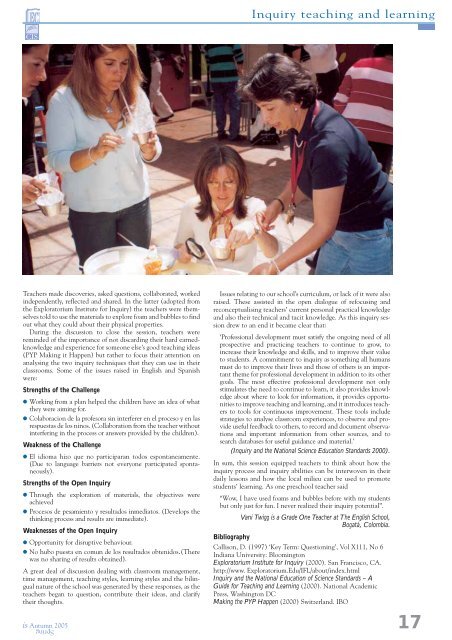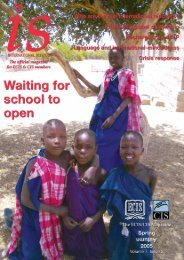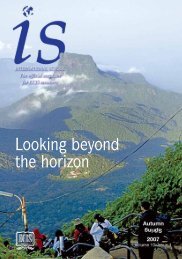is magazine 8.1 - Autumn/Spring 2005 - International Schools ...
is magazine 8.1 - Autumn/Spring 2005 - International Schools ...
is magazine 8.1 - Autumn/Spring 2005 - International Schools ...
You also want an ePaper? Increase the reach of your titles
YUMPU automatically turns print PDFs into web optimized ePapers that Google loves.
Teachers made d<strong>is</strong>coveries, asked questions, collaborated, worked<br />
independently, reflected and shared. In the latter (adopted from<br />
the Exploratorium Institute for Inquiry) the teachers were themselves<br />
told to use the materials to explore foam and bubbles to find<br />
out what they could about their physical properties.<br />
During the d<strong>is</strong>cussion to close the session, teachers were<br />
reminded of the importance of not d<strong>is</strong>carding their hard earnedknowledge<br />
and experience for someone else’s good teaching ideas<br />
(PYP Making it Happen) but rather to focus their attention on<br />
analysing the two inquiry techniques that they can use in their<br />
classrooms. Some of the <strong>is</strong>sues ra<strong>is</strong>ed in Engl<strong>is</strong>h and Span<strong>is</strong>h<br />
were:<br />
Strengths of the Challenge<br />
● Working from a plan helped the children have an idea of what<br />
they were aiming for.<br />
● Colaboracion de la profesora sin interferer en el proceso y en las<br />
respuestas de los ninos. (Collaboration from the teacher without<br />
interfering in the process or answers provided by the children).<br />
Weakness of the Challenge<br />
● El idioma hizo que no participaran todos espontaneamente.<br />
(Due to language barriers not everyone participated spontaneously).<br />
Strengths of the Open Inquiry<br />
● Through the exploration of materials, the objectives were<br />
achieved<br />
● Procesos de pesamiento y resultados inmediatos. (Develops the<br />
thinking process and results are immediate).<br />
Weaknesses of the Open Inquiry<br />
● Opportunity for d<strong>is</strong>ruptive behaviour.<br />
● No hubo puesta en comun de los resultados obtenidos.(There<br />
was no sharing of results obtained).<br />
A great deal of d<strong>is</strong>cussion dealing with classroom management,<br />
time management, teaching styles, learning styles and the bilingual<br />
nature of the school was generated by these responses, as the<br />
teachers began to question, contribute their ideas, and clarify<br />
their thoughts.<br />
<strong>is</strong> <strong>Autumn</strong> <strong>2005</strong><br />
<strong>Spring</strong><br />
Inquiry teaching and learning<br />
Issues relating to our school’s curriculum, or lack of it were also<br />
ra<strong>is</strong>ed. These ass<strong>is</strong>ted in the open dialogue of refocusing and<br />
reconceptual<strong>is</strong>ing teachers’ current personal practical knowledge<br />
and also their technical and tacit knowledge. As th<strong>is</strong> inquiry session<br />
drew to an end it became clear that:<br />
‘Professional development must sat<strong>is</strong>fy the ongoing need of all<br />
prospective and practicing teachers to continue to grow, to<br />
increase their knowledge and skills, and to improve their value<br />
to students. A commitment to inquiry as something all humans<br />
must do to improve their lives and those of others <strong>is</strong> an important<br />
theme for professional development in addition to its other<br />
goals. The most effective professional development not only<br />
stimulates the need to continue to learn, it also provides knowledge<br />
about where to look for information, it provides opportunities<br />
to improve teaching and learning, and it introduces teachers<br />
to tools for continuous improvement. These tools include<br />
strategies to analyse classroom experiences, to observe and provide<br />
useful feedback to others, to record and document observations<br />
and important information from other sources, and to<br />
search databases for useful guidance and material.’<br />
(Inquiry and the National Science Education Standards 2000).<br />
In sum, th<strong>is</strong> session equipped teachers to think about how the<br />
inquiry process and inquiry abilities can be interwoven in their<br />
daily lessons and how the local milieu can be used to promote<br />
students’ learning. As one preschool teacher said<br />
“Wow, I have used foams and bubbles before with my students<br />
but only just for fun. I never realized their inquiry potential”.<br />
Bibliography<br />
Vani Twigg <strong>is</strong> a Grade One Teacher at The Engl<strong>is</strong>h School,<br />
Bogatá, Colombia.<br />
Call<strong>is</strong>on, D. (1997) ‘Key Term: Questioning’, Vol X111, No 6<br />
Indiana University: Bloomington<br />
Exploratorium Institute for Inquiry (2000). San Franc<strong>is</strong>co, CA.<br />
http://www. Exploratorium.Edu/IFL/about/index.html<br />
Inquiry and the National Education of Science Standards – A<br />
Guide for Teaching and Learning (2000). National Academic<br />
Press, Washington DC<br />
Making the PYP Happen (2000) Switzerland. IBO<br />
17




